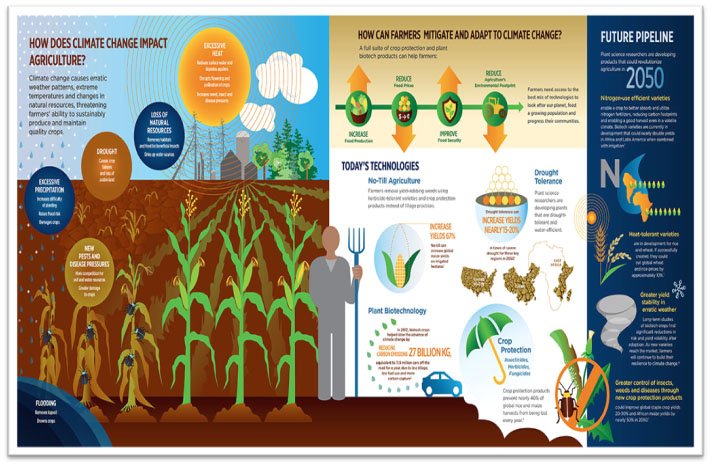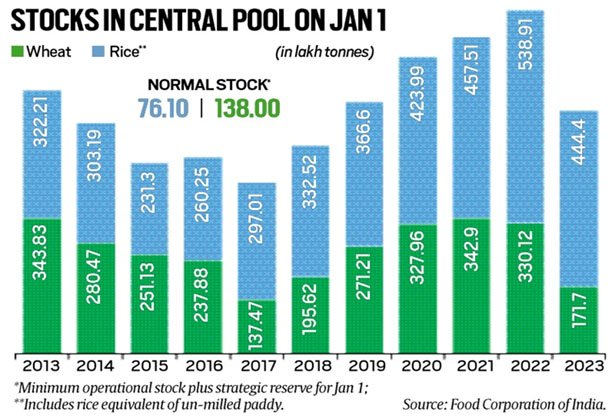DRY COLD WINTERS AND AFFECT ON RABI CROPS
Context: Climate change with irregular rainfall and sudden mercury surge after mid-March taking heavy toll on the standing wheat that was in the final ripening and maturity stage.

CLIMATE CHANGE AND AGRICULTURE

- Climate change had costed India 5 million hectares of crop in 2021 due to cyclonic storm, flash floods, floods, landslides and cloudbursts.
- FOOD SECURITY : Vulnerability of Indian agriculture due to problems associated with climate change and low adaptation capacity of majority of Indian farmers poses risk to food security of the country.
- As by 2030, India may need 70 million tonnes more food grains than the expected production in 2016-17.
- DECREASING PRODUCTIVITY: The decrease in productivity of major crops will be marginal in the next few years but it could fall to as much as 10-40% by 2100 unless farming adapts to climate change-induced changes in weath.
- REDUCED FARM INCOME :The government’s Economic Survey 2018 reports that every one-degree Celsius rise in temperature could reduce agricultural income by 6.2% in kharif and 6% in the rabi season in non-irrigated areas.
- Benefit to few crops: Though most crops will see reduced production, but climate change may also help improve yields of soybean, chickpea, groundnut, coconut (western coast) and potato (in Punjab, Haryana and western Uttar Pradesh).
ISSUE OF COLD DRY WINTERS ON RABI CROPS
- 2021-22 was the Year of Climate Change for Indian agriculture.
- Every single month from September 2021 to January 2022 recorded excess rain, which significantly damaged the post-monsoon kharif crop at the time of harvesting.
- The sudden mercury surge after mid-March took heavy toll on the standing wheat that was in the final ripening and maturity stage.
- On contrary, 2022-23 has been quite different. Rainfall was 37.4% below the all-India average in November, with the corresponding deficits at 14.5% for December and 57.5% during January 1-22.
- The shortfalls have been greater in northern, central, and western India, where much of the rabi winter-spring crops such as wheat, mustard, chickpea, and masur ,maize, potato and onion are grown.
IMPACT OF RABI CROPS
- MODERATING INFLATION: As farmers have sown wheat on 341.13 lakh hectares (lh) this time, which translates into bumper production. It will be helpful in moderating annual retail cereal led inflation.
- Bumper rabi crops is helpful in restocking of wheat stocks in government warehouses as they are currently at a six-year-low.

IMPACT ON WHEAT CROP
- Wheat that was sown before mid-November is now in the “boot” stage, where the earheads are forming at the top of the plants.
- The combination of sunny skies and low night temperatures that we are having is favourable for wheat.
- Appropriate rainfall will provide growth momentum to the crop by cooling the canopy and enabling natural nitrogen fixation.
- It will also save on irrigation costs as without rainfall it needs around five to six rounds of irrigation.
IMPACT ON CHICKPEA( CHANA)
- Chana is the second biggest rabi crop by area, with farmers sowing in 110.91 lh.
- There has been no loss from frost, as flowering will start only towards end ofJanuary and pod-setting 25-30 days after that.
- The crop condition is good, and any rainfall will be helpful at this point. Annually 65 to 95cm of rainfall is required for its cultivation.
- Excessive rains after showing, flowering stage will result in heavy loss in crop yield.
IMPACT ON MUSTARD
- Mustard is generally sown by October-end and starts flowering after 50-60 days and forming siliqua (pods containing seeds) over the next 35-40 days.
- Prevailing cold wave conditions over north india is believed to have cost frost damage to the standing crop.
- Clear sunshine in the morning and a sharp dip in night temperatures to near freezing point is not bad for wheat in the tillering/ booting stages but it can be disastrous for mustard.
- Favourable conditions for crop includes only light rain and no hail or strong winds, as it can lead to bending of crops.
WAY FORWARD
- Scientists say that moderately low temperatures in the range of 10 to 15 degrees bode well for winter crops.
- The Rabi crops per say grow well in the cold weather. But extreme cold waves like the one being witnessed these days can harm crops.
- Crops like mustard, castor and maize that have broad leaves are especially vulnerable. Dew accumulates and freezes on these leaves. The frost can cause the leaves to fall eventually, adversely affecting the crop.
- Scientists have been advising farmers to create smokescreens over their fields to counter the low temperatures. As smokescreen will prevent accumulation of dew on leaves.
Syllabus: Mains, GS3- Agriculture

